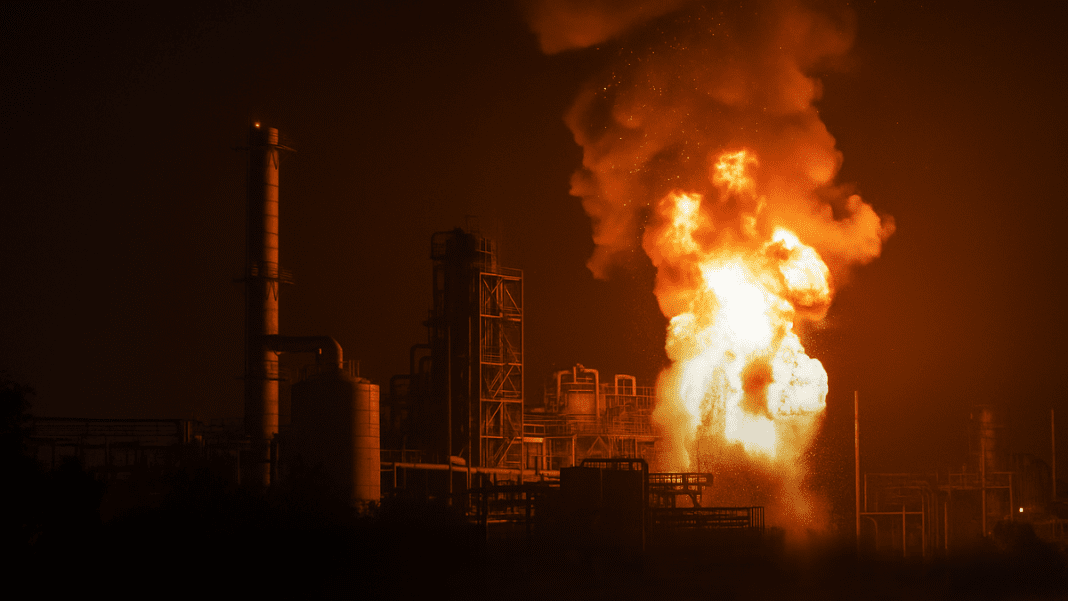A major chemical facility in Russia’s Stavropol region came under a dramatic drone attack on July 25. This plant, located in the industrial city of Nevinnomyssk, plays a vital role in the country’s ammunition production.
Powerful Chemical Plant Targeted by Drones
It manufactures key ingredients used to make military-grade explosives. The facility is known for producing nitric acid and ammonium nitrate, two substances commonly used in making powerful weapons such as artillery shells, air bombs, and multiple launch rocket systems (MLRS).
Residents living near the plant said they heard several loud explosions and saw bright flashes of light in the sky during the night. These eyewitness accounts matched with videos that quickly spread on social media, showing what appeared to be the moment of the strike. Several clips captured multiple blasts, suggesting more than one drone may have been involved in the operation.
The attack was later confirmed by local authorities, who released a video message stating the site had been hit. They claimed there were no injuries or obvious signs of damage. However, footage of the fire and impact has raised questions about how much of the facility might have been affected.
Ukraine Endures Deadliest Night of War: 298 Drones, 45 Missiles Rain Terror Across 13 Regions
Risky Areas Inside the Plant May Have Been Targeted
The Nevinnomyssky Azot chemical plant is a complex industrial site. It includes several high-risk production zones. Open-source intelligence groups examined video from the attack and believe that the drones likely hit the acetylene production site and a workshop known as number nine. That specific area handles acetaldehyde production, which is known to involve highly flammable materials.
When chemical plants like this are hit, the danger isn’t just from the explosion itself. It’s also about what could happen afterward. Acetylene and acetaldehyde are both extremely volatile chemicals. Even small disruptions in these zones could cause major fires or toxic leaks. That makes the risk to both the plant and nearby communities very serious, even if the visible damage appears minimal at first glance.
Even though no injuries were officially reported, the full extent of the strike’s impact is still unclear. Experts who reviewed the available footage noted that targeting such sensitive areas could lead to dangerous consequences beyond the initial blast. The scale and type of fire seen in some videos suggest that parts of the facility may have been temporarily disabled.
Russia’s Chemical Facility Tied to Explosives Production Nationwide
This chemical plant isn’t just any industrial facility. It has deep links to Russia’s broader weapons supply chain. According to multiple sources, the nitric acid produced here is sent to the Sverdlov Plant in Russia’s Nizhny Novgorod region. That facility uses it to create high-power military-grade compounds like HMX (also called octogen) and RDX (known as hexogen).
These two explosive chemicals are among the strongest non-nuclear materials used in modern weaponry. They are used to fill bombs, warheads, and other powerful munitions. A disruption in the production of nitric acid can directly affect how much of these materials can be manufactured.
This isn’t the first drone-related attack on strategic industrial sites inside Russia. Just days before this strike, a major oil depot in the Adler district of Sochi was also hit. That attack caused a large fire in one of Russia’s most popular resort areas on the Black Sea.
The repeated strikes highlight a new pattern where drones are being used not only on the battlefield but deep behind enemy lines. Industrial plants, especially those that feed the military supply chain, appear to be increasingly in the crosshairs.
🔥 Ukraine’s drone strikes breach deep into Russian cities, hitting Kronshtadt plant and Splav
The Nevinnomyssky Azot plant has long been considered a key part of Russia’s defense production network. Disrupting this plant’s operations—even temporarily—could create significant challenges in maintaining a steady supply of explosive materials needed for ongoing military efforts.
While official sources downplayed the damage, the footage and analysis suggest that this drone raid may have dealt a serious blow to one of Russia’s key explosive chemical suppliers.

